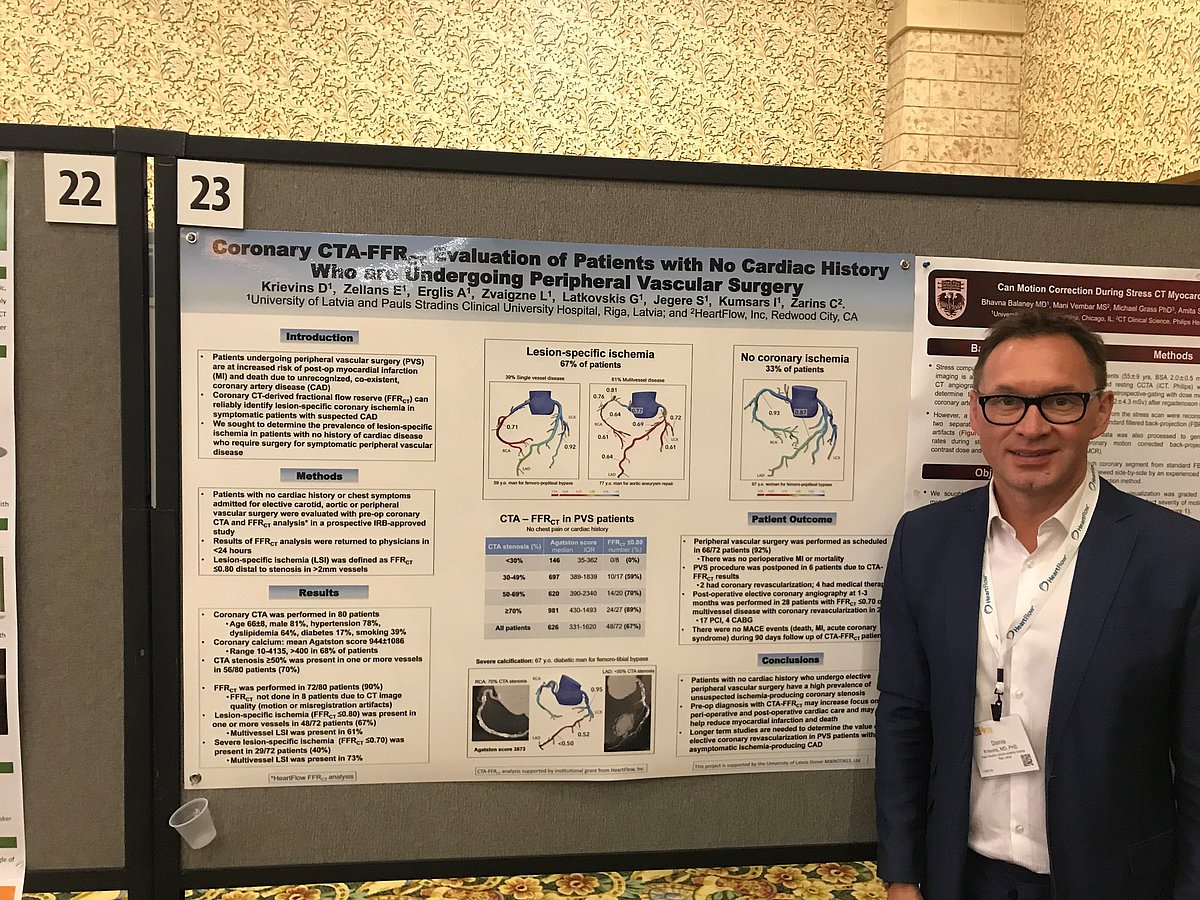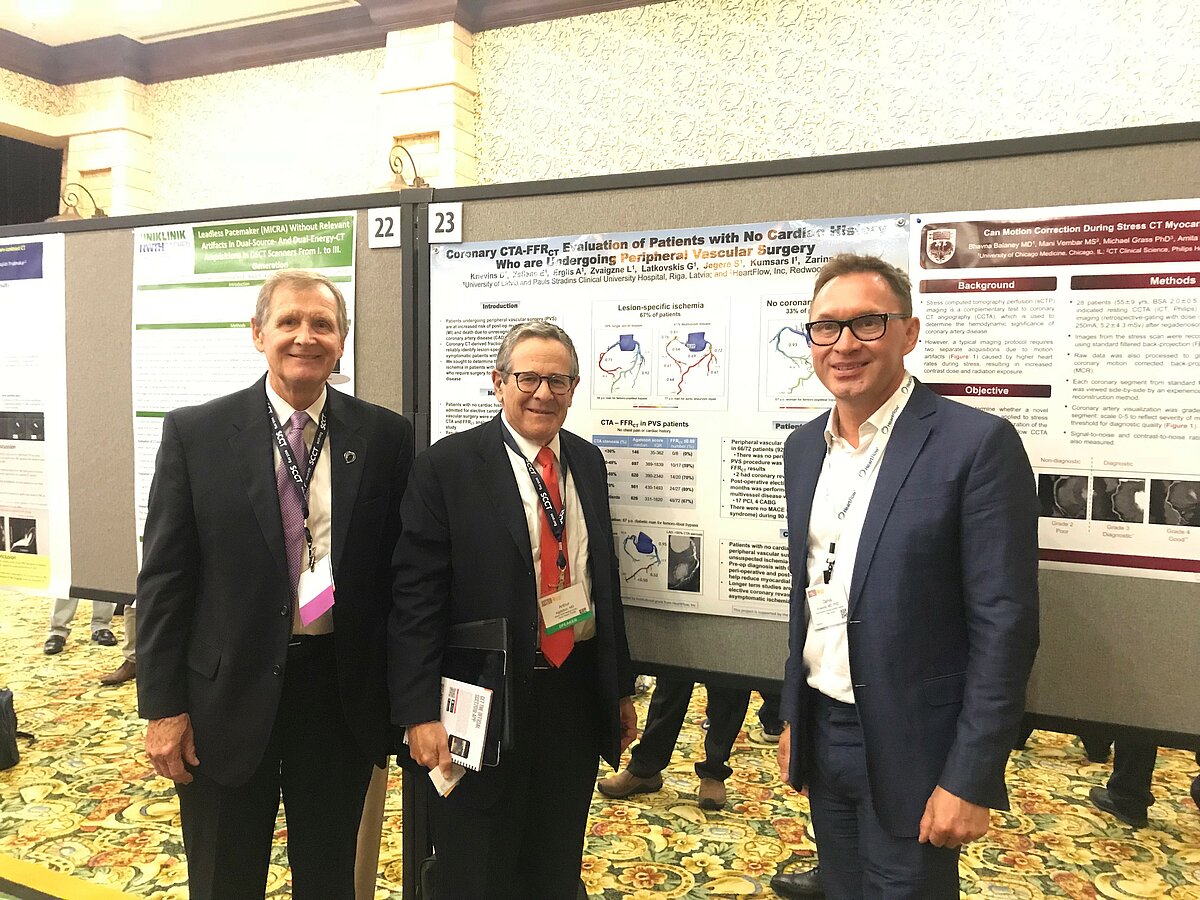
202 million people suffer from PAD, 40 million of them – in Europe
The most frequently blocked arteries due to PAD are those of legs. Symptoms include complaints of pain when walking, which subside when stopping, ulcers on the feet, bluish and cold skin, as well as other symptoms. Beyond affecting the quality of life, in case of complications this disease can lead to gangrene and leg amputation. Therefore, the patients often need to be treated with surgical methods. CAOD, in turn, narrows and clogs the main arteries that supply the brain and is responsible for many strokes. Stroke is a deeply disabling pathology with high mortality. Early surgical treatment of CAOD is also the most effective way to prevent stroke.
At the same time, patients with PAD and CAOD have often been associated with concomitant cardiovascular disease (CCD), which is responsible for patient mortality both in the perioperative period and in later years, reaching 48 % over a seven-year period (Danish National Register, 2015). Often, the detection of these cardiovascular diseases is delayed because patients may have no clinical symptoms and there is currently no proven effective non-invasive diagnostic method for cardiovascular system. Specialists emphasize that various cardiovascular events in the perioperative period can significantly affect the patient's quality of life and survival. The perioperative period includes the impact of various medical conditions on the upcoming surgery. This includes pre-operative education of the patient, assessment of surgical risk, appropriate perioperative and post-operative cardiovascular treatment.
The patron of the UL Foundation supports the world's first unique method in the field of combatting cardiovascular diseases
The project is implemented with financial support of the patron “Mikrotīkls”. The allocated funding of EUR 80 000 is administered by the UL Foundation. The aim of the project is to develop a method and an innovative strategy to assess the significance of cardiovascular damage non-invasively by employing multilayer computed tomography angiography (CTA), and processing the data with a “supercomputer” and select the appropriate treatment of the patients. Until now, after CTA it was possible to assess only cardiovascular images, provided that the blood vessels were not too calcified. This anatomical representation of blood vessels could be misinterpreted because it did not provide a notion of the extent of mechanical damage in myocardial bleeding. Upon observing cardiovascular damage, patients had to be referred for an invasive examination (coronary angiography) to decide on further treatment tactics. The results of various studies show that approximately 56 % of patients fail to be assessed according to CTA data, and therefore not referred for further treatment. On the other hand, unfounded hyperdiagnosis, when patients undergo unnecessary invasive cardiac examinations, reaches 25 %. Due to the invasiveness of current methods of accurate cardiac examination and the lack of non-invasive examination methods, cardiac examination of patients without clinical symptoms is not routinely recommended in either international or local guidelines.
The new method (fractional flow reserve after coronary computed tomography angiography (CCTA) – FFRCT) will help to ensure that the number of patients who have to be referred for further invasive cardiac examination is significantly reduced. This method enables a more precise selection of the patients who need further treatment. This is the first unique technique in the world that can accurately determine not only the anatomy of cardiovascular damage, but also its hemodynamic significance with non-invasive methods.
Prevention of patient mortality and disability caused by myocardial infarction
The duration of the pilot project will be 5 years, and the observations and data will be collected for the first three years. The project implementer, professor at the University of Latvia Faculty of Medicine, vascular surgeon Dainis Krieviņš has already participated in several international conferences, presenting the results of the first six months obtained in evaluating cardiovascular patients in need of peripheral vascular reconstruction. “It is important to discuss these results in the international community in order to have a better overview of the project's progress and to determine if there is a room for improvement. Attending international conferences is especially important for Latvian scientists to show innovation and to receive criticism, thereby moving in the right direction,” says D. Krieviņš. The first results currently confirm the initial hypothesis advanced by the team of scientists – in patients whose treatment has been directed only at blood vessels of the legs or brain and who do not have cardiac complaints, in more than 66 % of cases a cardiovascular disease is identified and a complex illness is detected. It is also concluded that by aggressive treatment of patients (beyond recommending a correct lifestyle – not smoking, exercising, eating healthy, ensuring a suitable environment, avoiding stress, also by prescribing drugs that reduce the illness or diminish its complications and, if necessary, actively referring patients to invasive cardiologists and cardiac surgeons to repair cardiovascular damage) can prevent patient mortality and disability brought about by myocardial infarction.
Outstanding cardiovascular surgeons of Latvian origin worldwide
The project is international, implemented in cooperation with Silicon Valley (California, USA) medical technology company HeartFlow, Ltd. One of its co-founders is an outstanding vascular surgeon of Latvian origin, patron of the University of Latvia Professor Dr. Kristaps Zariņš, professor emeritus of Stanford University. This company provides data processing and analysis with a “supercomputer”, creating a 3D model of the coronary arteries and a flow adequacy map for the myocardium from the obtained data.

From left: Dr. Kristaps Zariņš, Dr. Arthur Agatston and Dr. Dainis Krieviņš.
The participation in the 13th Annual Scientific Meeting of the International Society of Cardiovascular Computed Tomography (SCCT) in Dallas, USA has been of a particular significance. The event annually brings together doctors and healthcare professionals, offering a comprehensive presentation on the latest developments in the field of cardiovascular disease prevention. Notably, during the event D. Krieviņš and Kristaps Zariņš met in person. There was also an opportunity to meet with Dr. Arthur Agatston. He is a historical personality, whose name has been given to the assessment value of CTA examination – Agatston score. This is the principle of degree measurement to assess calcium by means of coronary computed tomography. Interestingly, Agatston's grandfather was Latvian.
Basis for medical algorithm and guidelines
The team that develops the project and draws the main conclusions is multidisciplinary from the point of view of specialties, bringing together vascular surgeons, anaesthesiologists (including Dr. Edgars Zellāns) and leading Latvian cardiologists (cardiologists of P. Stradiņš Clinical University Hospital Prof. Andrejs Ērglis, Prof. Gustavs Latkovskis, Assistant Prof. Indulis Kumsārs and Dr. Sandra Jēgere), cardiac surgeons (including Associate Prof. Pēteris Stradiņš) and radiologists (including Dr. Ligita Zvaigzne). Medical students, doctoral degree students, as well as nurses are also involved in the project. “After attending the first conferences, there is a lot of interest from the colleagues of other countries, because so far nothing similar has been done in this area. The results of our research can provide a great deal of added value – many lives are saved by increasing people’s survival and quality of life,” says D. Krieviņš, who plans to take the project to an international level. Industry experts from Denmark, South Korea, Japan, Germany and the Netherlands have already shown interest in cooperating. The project implementers want to successfully complete the project and aspire to inclusion of the project results in international guidelines and entry into international circulation.
The particular merit of the project lies in the fact that the assessment and interpretation of the results in patients with PAD and CAOD operated with FFRCT has not yet been performed. Therefore, the exact incidence and severity of coronary heart disease in these patients in Latvia is unknown. This is the beginning of assessing the opportunities for applying a new, non-invasive method to patients with vascular damage. With FFRCT, it would be possible to diagnose and effectively treat cardiovascular pathology in the perioperative period, thus reducing patient mortality both in the early postoperative period, as well as in the later period. Simultaneously, it would be possible to avoid unnecessary invasive diagnostic coronarographies, thus saving significant financial resources in the medical budget and avoiding possible complications for the patient during the invasive examination.
If successful, the project could serve as a basis for changes in the medical algorithm, as well as local and international guidelines for patients undergoing PAD and CAOD revascularization surgeries.
About the University of Latvia Foundation
Since 2004, the University of Latvia Foundation has provided an opportunity for patrons and cooperation partners to support the University of Latvia and other leading Latvian higher education institutions, thus investing in the future of Latvia. The priorities of the UL Foundation are the support to the best students and researchers, promoting creation of a modern study environment, as well as construction and redevelopment of university buildings.

 Academic Centre
Academic Centre